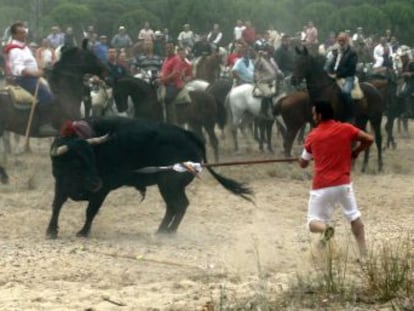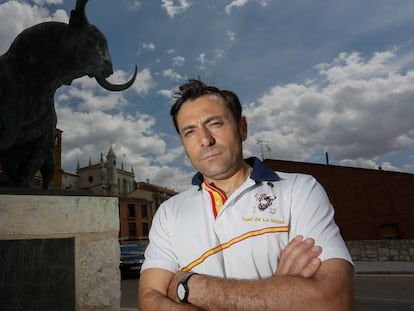Spanish town replaces bull spearing fiesta with a deathless hunt
But residents of Tordesillas are very unhappy about the ban on their time-honored tradition
The Toro de la Vega is history.
On Tuesday morning, a new era began for a controversial bull-hunt that has been held in the Spanish town of Tordesillas since medieval times.
Tordesillas cries out for tradition, democracy and freedom!
Marchers at a pro-hunt rally
The renamed event, Toro de la Peña, still featured a bull getting chased by humans on foot and on horseback. The difference was that hunters were no longer allowed to kill it with spears under new rules introduced by the regional government.
At 11.15am, a 640-kilogram bull named Pelado was let loose in the streets of Tordesillas, in Valladolid province. The animal was steered down toward the bridge over the Duero river. Pelado crossed it, leaving the town behind and entering the countryside, where the hunt got underway.
It began to rain shortly afterwards, and the bull soon returned to the center of town with a crowd of people in tow. At around 12.10pm, a firecracker went off, signaling the official end to Tordesillas’ first ever Toro de la Peña. People started heading back into town; Pelado was to be taken to a nearby corral.
Banned in May
In May, the regional government of Castilla y León issued a ban on killing bulls during public fiestas such as this one. The new rules mean that hunters may no longer spear the animal, either. Tordesillas tradition had mandated that the first person to lance the bull got to finish it off in a one-on-one face-off between man and animal.
The ban came after growing annual clashes between animal-rights activists and defenders of the local fiesta, who feel that outsiders have come to impose their views and destroy their time-honored custom.
In a bid to calm the waters, Tordesillas officials had been insisting that apart from not killing the bull, everything else would remain the same.
“It will not be our timeless Toro de la Vega. But it will run down the same course as always,” noted a brochure handed out by local authorities. But even the mayor, José Antonio González of the Socialist Party (PSOE), publicly lamented that “we’ve been orphaned.”
More clashes
But the confrontation between supporters and detractors of the event did not end this year. Around 3,000 people gathered in the central square at 10am to protest the “dictatorial” regional decree and to defend their “freedom to hold the fiesta.” Marchers held up a large sign with the slogan “Tordesillas no se rinde” (“Tordesillas is not giving up”).
A ban in the 1960s
Between 1964 and 1977, when Spain was still under the Franco dictatorship, national authorities banned the killing of the bull during local fiestas. A decree signed in 1963 prohibited all public spectacles that entailed animal abuse, even traditional ones such as Toro de la Vega. The only exception was the official bullfights held inside the rings.
The point was to establish a clear difference between the "art" of real corridas de toros, which Spain wanted to make more prestigious, and the savagery of other bull-related fiestas held across the Spanish geography, which Madrid wanted to phase out.
But locals ignored the ban and killed the bull anyway in 1964 and 1965, leading to several arrests.
Some animal-rights activists also showed up, but the Civil Guard was on hand to prevent major clashes. A man was arrested after refusing to hand over a spear to officers.
An animal-rights activist was reportedly injured at around 10.45am after coming out in defense of a young woman who was having an argument with Toro de la Vega supporters. “They were hitting her and I tried to separate them, and then they hit me in the back,” said the activist.
Toro de la Vega supporters read out a manifesto stating that their town is being unfairly targeted by the media. Their final cry was “Tordesillas cries out for tradition, democracy and freedom!”
English version by Susana Urra.
Tu suscripción se está usando en otro dispositivo
¿Quieres añadir otro usuario a tu suscripción?
Si continúas leyendo en este dispositivo, no se podrá leer en el otro.
FlechaTu suscripción se está usando en otro dispositivo y solo puedes acceder a EL PAÍS desde un dispositivo a la vez.
Si quieres compartir tu cuenta, cambia tu suscripción a la modalidad Premium, así podrás añadir otro usuario. Cada uno accederá con su propia cuenta de email, lo que os permitirá personalizar vuestra experiencia en EL PAÍS.
¿Tienes una suscripción de empresa? Accede aquí para contratar más cuentas.
En el caso de no saber quién está usando tu cuenta, te recomendamos cambiar tu contraseña aquí.
Si decides continuar compartiendo tu cuenta, este mensaje se mostrará en tu dispositivo y en el de la otra persona que está usando tu cuenta de forma indefinida, afectando a tu experiencia de lectura. Puedes consultar aquí los términos y condiciones de la suscripción digital.











































